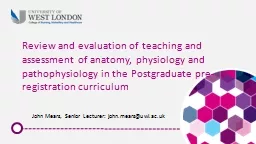

John Mears Senior Lecturer johnmearsuwlacuk Incarnations of the module Applied Physiology assessment and management of acute care conditions Sept 2010 Feb 2013 Biomedical sciences applied to nursing practice Sep ID: 566724
Download Presentation The PPT/PDF document "Review and evaluation of teaching and as..." is the property of its rightful owner. Permission is granted to download and print the materials on this web site for personal, non-commercial use only, and to display it on your personal computer provided you do not modify the materials and that you retain all copyright notices contained in the materials. By downloading content from our website, you accept the terms of this agreement.
Slide1
Review and evaluation of teaching and assessment of anatomy, physiology and pathophysiology in the Postgraduate pre-registration curriculum
John Mears, Senior Lecturer: john.mears@uwl.ac.ukSlide2
Incarnations of the module
Applied Physiology: assessment and management of acute care conditions: Sept 2010 – Feb 2013
Biomedical sciences applied to nursing practice: Sep
2013
- presentSlide3
Context of the current module
The module sits in stage 2 of the programme (approx months 8 -15)
Runs concurrently with ‘Enhancing adult and mental health practice through decision making’Slide4
Context of the current module -2
The Biomedical Science module content is structured to match the content of the Decision Making module bringing the pathophysiology into context particularly for adult healthSlide5
Student numbers
September every year 50+ students taught as 2 groups
~25 mental health London based
~20 adult health/~5 mental health Reading based taught as a single group
February – depends on contract, if running adult only at ReadingSlide6
Context (module) problems
Structure of the course: There is no earlier anatomy and physiology module
Need to include anatomy and physiology in the module
Time constraints/limited study days
Limited clinical experience prior to the module
Mix of mental health and adult health students at Reading and mental health in LondonSlide7
Student problems
Significant numbers of students have extremely limited experience with biology or any other science.
In the last cohort of the students at Reading over one third had not studied any science since GCSE or ‘O’’ level
Very wide range of subjects studied for first degree. Many with no connection to scienceSlide8
Developing Solutions - Structure
Revalidation changed the emphasis of the module leaving out management and focusing on assessment using altered physiology
Retained related pharmacology as there is no dedicated module for this
Focus on a limited number of specific conditions to illustrate some of the key aspects of pathophysiology the majority of which may be found in adult and mental health contextsSlide9
Developing solutions - Resources
T
he
usual PowerPoint and word resources on
Blackboard, YouTube videos.
WileyPlus
online anatomy and
physiology
was
used as
a pilot which was well received but wasn’t perceived as meeting the need of the students
Now using Primal
online with tutor resources available to download to Blackboard. This is well received by students and
w
e
are currently evaluating this.Slide10
Developing solutions – Resources 2
Because of a number of technical issues we have not to date used the on-line resources early in the course. This semester the September 2015 students will receive guidance and access near the beginning of the course. This is in response to student evaluations.Slide11
Developing Solutions -Assessment
Originally 3 hour exam using questions related to a scenario.
With revalidation 3 hour exam with multiple choice and short answer questions
Now 30 minute OSCE and viva voceSlide12
OSCE/Viva voce process
Students given 4 possible scenarios one of which they will undertake
Formative table top version to practice in class
A brief assessment of simulated patient to show structure and to gain information relating to the patient. Viva using a semi-structured approach based on A&P and pathophysiology
Probing to allow and encourage students to give relevant informationSlide13
Rationale for OSCE/Viva voce
External
examiner felt
that we could
be over
assessing the students
Poor pass rate at first attempt
Relates directly to practice
Video the procedure for review and
moderation
Examiners can probe to enable students to find answers